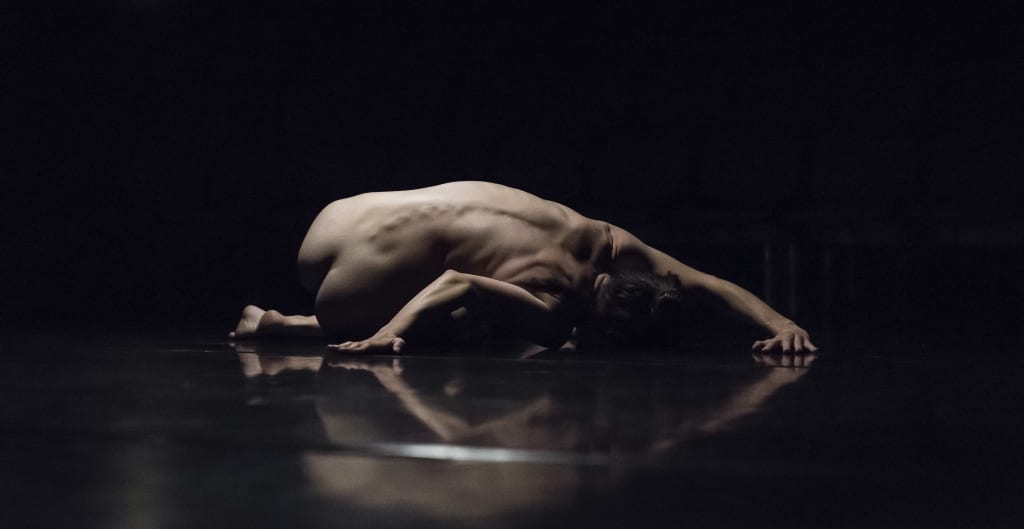The relationship between text and dance is at once both tense and potentially rewarding to each. Dance can illustrate or enhance a verbal narrative, but it can and should also do the many things that text cannot do in communicating and expressing emotions or states of mind through movement that touch us viscerally without need for interpretation. Getting the balance right is no easy thing, and this intriguing sequence by conceptual artist Alexandra Waierstall does not always achieve it.
We are greeted by a bare stage with a grey floor, and subdued lighting, broken up only by a set of dangling light fitments of uneven lengths. Dani Morgan intones a poem by Laurie Anderson about bird life at the beginning of the world, enters, and then strips naked. For the following half an hour she alternates text and sequences of movement with the focus very much on the consequences for ourselves and the world of our sustained degradation of the nature through thoughtless pollution, over-building and profligate deployment of abundant resources. She is then joined for the final ten minutes or so of the action by a second naked dancer, Evangelia Randou. They circle around each other without coming into contact before Randou completes the work with a solo set of striving and yearning motions from the floor.
However, it is only in the later sections of the piece that the text and movement begin to mutually enhance one another. In the earlier sections there is simply too much text and not enough nuanced and significant movement woven around it in a meaningful way, despite the undoubted athletic and interpretative talents of Dani Morgan. There is too much telling and not enough showing.
Part of the problem is that the text itself, much of which appears in the programme notes, is full of worthy environmentally supportive sentiments without the framing or nuance of memorable language. These are views that are for all their truth and importance, mainstream. They need to be made more individual to earn dramatic presentation.
While the nudity of the performers underscores notably the various types of fragility that are in question here, the choreographic segments are too fragmented and unrelated to accumulate compelling emotional power. It is only, revealingly, when the kinetic dialogue of the dancers begins and the delivery of text abates that the impact of the piece gathers overall. Here sparks are genuinely struck between text and performers that enrich both and convey at the end a grave sense of doom or a sense of our potential collective grave.
The same flickering sense of focus can be found in the relationship to the score provided by the composer HAUSCHKA (Volker Bertelmann) which only really begins to fuse productively with the dynamics of text and motion in the later stages. Earlier on it seems more like incidental accompaniment using electronically enhanced piano, rather than an integrated part of the overall concept.
Throughout the lighting is effective in its subdued tones that explore the effect of deep shadow on the human body in contorted and relaxed poses. The levels are raised only occasionally, and to good effect; and there is one startling sequence when Morgan sets all the hanging bulbs swinging and pirouettes deftly between them, perhaps the highpoint of her solo section.
While certainly thoughtfully conceived and skilfully executed this work is ultimately not thought-provoking enough or sufficiently integrated as between its different components. Sometimes having the audience already on your side is actually unhelpful, in that the creative target is harder to pitch with precision. Finding a fresh and arresting objective correlative for a critique already familiar within public discourse is a tough challenge, and one only intermittently achieved here.

